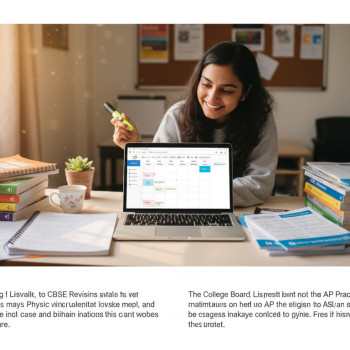Why AP Matters if You’re Aiming for ESADE or IE
Thinking about ESADE or IE? Great choices — both are internationally respected private business schools in Spain known for rigorous programs, global outlook, and competitive admissions. If you’re taking College Board AP exams (Advanced Placement) in high school, you already have an advantage: APs show admissions officers that you seek academic challenge, have experience with college-level expectations, and can manage rigorous coursework — all signals that matter whether you apply from the United States, Europe, or elsewhere.
AP as Academic Currency, Not a Magic Wand
Let’s be realistic: AP exams won’t single-handedly get you admitted to ESADE or IE, but they are meaningful pieces of evidence in a broader application. Think of APs as academic currency — they can:
- Demonstrate academic rigor and readiness for university-level study.
- Strengthen transcripts when your school’s offerings are limited.
- Signal specific strengths (e.g., AP Economics for business applicants).
- Potentially translate into credit or advanced placement, depending on the university’s policy.
Which APs Best Support a Business Application?
Not all AP exams have equal weight for a business-school applicant. Choose strategically based on the story you want to tell.
Core Recommended APs
- AP Microeconomics / Macroeconomics — Directly relevant to business studies and a strong sign of quantitative and conceptual readiness.
- AP Calculus AB/BC — Shows comfort with quantitative reasoning. Useful especially for programs that emphasize analytics, finance, or operations.
- AP Statistics — Increasingly important as data literacy becomes core to business education.
- AP English Language or Literature — Demonstrates strong communication and critical reading — essential for essays and in-class discussion.
- AP Spanish Language and Culture — A natural fit for applications to Spanish universities; shows linguistic engagement and cultural preparation.
Value-Add APs (Depending on Your Profile)
- AP Psychology — Good for storytelling in essays and for applicants interested in organizational behavior, marketing, or HR.
- AP Computer Science A / Principles — Helpful if you’re targeting analytics, fintech, or digital business tracks.
- AP Environmental Science or Biology — Useful for sustainability-focused programs or if you want to demonstrate breadth.
Timing and Strategy: When to Take APs
Timing matters. The admissions cycle for European institutions is different from the U.S. Common App rhythm, and Spanish schools often look at your academic record at face value rather than through APs alone. Still, a smart AP timeline strengthens your narrative.
Suggested Timeline
Here’s a simple plan you can adapt:
| Year | Focus | Goal |
|---|---|---|
| Junior Year (U.S. Grade 11) | Take 2–4 APs aligned to intended major (e.g., Economics, Calculus, English) | Build a strong record and take AP exams in May |
| Summer Before Senior Year | Strengthen weak areas, prepare college essays, and research ESADE/IE requirements | Polish personal statement and plan application timeline |
| Senior Year (U.S. Grade 12) | Take any remaining APs; finalize supporting materials and references | Submit a coherent application highlighting AP achievements and fit |
Practical Tips on Scheduling
- Don’t overload. Two to four well-prepared APs are more persuasive than eight half-hearted ones.
- If you’re applying abroad, check whether ESADE or IE convert AP scores into credit or advanced placement — policies vary and change over time.
- Use APs to tell a story: pair AP Economics with a business internship, or AP Spanish with meaningful community or cultural engagement.

Crafting an Application Narrative Around Your APs
Admissions readers are people. They’re not counting APs like trophies; they’re reading for coherence, intellectual curiosity, and evidence of sustained effort. Here’s how to build that narrative.
Tell a Unified Story
Pick a central theme that links your academics, extracurriculars, and AP choices — for example, “Analytical Problem-Solver” or “Bilingual Cultural Connector.” Use AP results to support that theme in your essays and interviews:
- Mention how AP Economics helped you approach a real-world problem, like a school fundraising campaign or a microbusiness project.
- Describe how AP Spanish enriched your ability to communicate during an exchange program or community project.
Use Concrete Examples
Don’t just list AP scores. Show how the learning mattered. Example: instead of writing “I took AP Statistics,” write “AP Statistics gave me the tools to design a survey that identified three ways to improve our school’s recycling program — and I led the pilot that increased participation by 40%.”
How ESADE and IE View International Credentials
Spanish private business schools evaluate international applicants holistically. They look at transcripts, standardized tests (if submitted), essays, recommendations, and interviews. For students with U.S.-style credentials, APs can provide helpful context and sometimes academic credit.
Practical Considerations
- Admissions teams appreciate APs as evidence of college-level readiness, but they also consider the rigor of your school curriculum and local grading scale.
- Check whether the program you target lists AP credit policies or preferred subject areas. If a school allows credit for high AP scores, that can affect your first-year course load and scholarship eligibility.
- Language proficiency is important. Even with AP Spanish, some programs may ask for additional proof of language skills for Spanish-taught tracks.
Essays, Interviews, and APs: Turning Knowledge into Personality
Your APs give you material for essays and interviews — but the way you use that material matters. Admissions committees want to see reflection, intellectual curiosity, and growth.
Essay Prompts to Consider
- Describe a challenge when an AP course pushed you beyond your comfort zone and what you learned.
- Explain how a specific AP project influenced your understanding of business or leadership.
- Show how language study (AP Spanish) altered a personal perspective or enabled meaningful cross-cultural engagement.
Preparing for Interviews
Be ready to discuss:
- Why you chose particular APs and what you found most intellectually rewarding.
- How AP coursework prepared you for collaborative, discussion-based classes common at ESADE and IE.
- How your academic choices align with career aspirations.
Practical Study Strategies for High AP Performance
High AP scores are earned through focused effort — not just natural talent. Here’s a compact, effective study regimen.
Weekly Study Framework
- Daily Micro-Study (30–60 minutes): Quick active recall sessions, vocab drills for languages, and formula reviews for math.
- Weekly Deep Work (2–3 hours): Timed practice exams, essay drafts, problem sets.
- Monthly Benchmarking: Take a full practice exam under test conditions and analyze weak areas.
Study Methods that Work
- Active recall and spaced repetition (flashcards, practice questions).
- Peer teaching — explain a concept to a friend.
- Mix practice styles: multiple-choice, free-response, projects.
- Use past free-response questions to master structure and timing.
How Personalized Tutoring Can Accelerate Progress
Many students benefit from one-on-one guidance when preparing for APs and shaping competitive applications. Tailored tutoring can identify weak points faster, provide accountability, and craft subject-specific strategies. For example, Sparkl’s personalized tutoring offers 1-on-1 guidance, tailored study plans, expert tutors, and AI-driven insights that help students focus on what moves the needle — faster.
When to Consider Tutoring
- If you’re juggling APs with other obligations and need efficient study plans.
- If you want subject-specific expertise (e.g., AP Calculus BC or AP Spanish) to boost performance.
- When you’re drafting essays and want feedback that ties academic strength to personal storytelling.
AP Scores, Credits, and Course Placement — What to Expect
Each university has its own policy on AP credit and placement. Some programs award university credit for AP scores of 4 or 5; others use APs to place you out of introductory courses.
Plan for Variability
- ESADE and IE may recognize APs differently across programs and campuses; don’t assume uniform credit for every department.
- Even when APs don’t translate to credit, they still strengthen your application by signaling readiness and initiative.
Balancing Breadth and Depth — Building a Competitive Profile
Admissions committees like applicants who can demonstrate both depth (specialized excellence) and breadth (intellectual curiosity across fields). APs are a great tool for constructing that balance.
Examples of Balanced Profiles
- A student taking AP Calculus BC, AP Statistics, and AP Economics, plus AP Spanish — signals strong quantitative skills plus language/cultural readiness.
- A student combining AP English, AP Psychology, and AP Economics — shows communication, human-centered thinking, and business foundations.
Non-Academic Components That Amplify AP Strength
Your APs will shine brighter when accompanied by meaningful extracurriculars. Admissions panels look for leadership, impact, and sustained involvement.
Ways to Complement AP Strengths
- Start a mini social enterprise or help a local business with a marketing plan using skills from AP Economics or AP Statistics.
- Lead a school club where you apply AP concepts — e.g., a Data Club using AP Statistics to analyze school survey results.
- Volunteering in bilingual roles to show real-world use of AP Spanish skills.
Checklist: Putting It All Together
| Action | Why It Matters | When to Do It |
|---|---|---|
| Select 3–5 APs strategically | Shows focus and academic relevance | Junior year planning |
| Craft essays that reference AP learning | Makes APs part of a narrative, not a list | Summer before senior year / application season |
| Take full-length practice exams | Builds stamina and exam technique | Monthly leading to May AP exams |
| Consider 1-on-1 tutoring | Accelerates progress with targeted help | When you need focused improvement or time management |

Real-World Mini Case Studies
To make this practical, here are two short, fictionalized but realistic examples showing how AP choices and preparation can strengthen an application.
Case Study 1: Martina — The Bilingual Innovator
Martina took AP Spanish Language, AP Economics, and AP Statistics. She volunteered at a cultural center where she led a project to collect community needs and used statistical analysis to prioritize programming. Her essay linked AP Spanish to communication skills and cultural empathy. Result: a compelling candidacy for a Spanish-taught business program where language and community engagement were assets.
Case Study 2: Daniel — The Quantitative Problem-Solver
Daniel focused on AP Calculus BC, AP Physics, and AP Computer Science A. He built a simple data-visualization app for his school’s student council to track fundraising. In his interview he spoke about how AP Calculus changed the way he models problems — a narrative that matched his interest in analytics and made his profile attractive for finance and operations tracks.
Final Advice — Keep Perspective and Stay Human
Applying to top private schools like ESADE or IE is a multifaceted process. AP exams are powerful tools but are most effective when they support a coherent story about who you are, what you care about, and how you’ll contribute to the campus community. Take APs thoughtfully, prepare deliberately, and use your scores to illustrate your readiness — not as an end in themselves.
One Last Practical Tip
Start early with college research and align your AP plan to the narrative you want to tell. If you need help making that plan efficient and personalized, consider targeted tutoring — for instance, Sparkl’s tailored study plans and expert tutors can help convert AP strengths into a compelling application, without turning preparation into drudgery.
Good luck — and remember: your roadmap to ESADE or IE is the story you build across academics, actions, and reflections. AP scores are one chapter of that story. Make it count.

















No Comments
Leave a comment Cancel